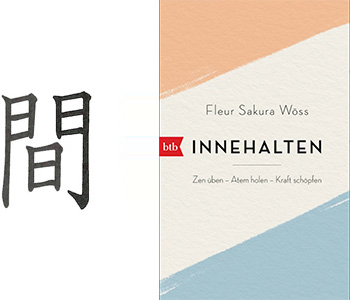
About »Innehalten« (To pause). A favourite book
„Innehalten” (To pause) is a book that a dear friend gave me years ago. I have since passed it on many times and read it several times. A book about the important pauses in life, about nothingness, about the space in between and the Japanese word ma.
Innehalten. Zen üben – Atem holen – Kaft schöpfen
(To pause. Practising Zen - taking a breath - gaining strength)
Fleur Sekura Wöss. penguin, Munique. 2007.
fleurwoess.com
February 2024
"A Zen teacher's gift to people in search of stillness, strength and serenity" is written on the back of the book. And that's exactly how it is. "Innehalten" is a book that I will read again and again. Because it is so clear, simple and logical. Its author Fleur Sakura Wöss was born in Tokyo. Its author, Fleur Sakura Wöss from Vienna, was born in Tokyo. She lived, taught and researched in Japan for many years and previously studied Japanalogy, Buddhism and Sanskrit. Together with her partner, Wöss founded the Zen Centre in Vienna in 2006 and has been running it ever since. When asked who she is, she refers to the wisdom of old Zen masters with "I don't know" on her website.
This is not intended to be a classic summary of content or a summary of Innehalten. Rather a rendition of what spontaneously comes into my mind when I think about it. As already mentioned, it is about nothingness. About the space in between, the pause, the zero. Wöss refers to many areas of everyday life, to learning and non-thinking, to music and art through to architecture and urban planning. And to the little word ma, expressed in the Japanese character, here on the left in the illustration.
ma, writes Wöss, is the Japanese word for space in between and plays a major role in Japan. It cannot be measured in terms of time or space and can be the space between people or objects, a pause in a conversation, the empty space between musical notes and generally the period of pause, the pause between breathing in and out. There are also many other meanings. ma stands for a fulfilled and necessary emptiness. Wöss translates it as: Leisure, free space, time out, nothing, grey area, break, time window, play space, gap, emptiness. I personally find the graphic character for ma extremely fascinating, which is why the corresponding passage from the book is reproduced verbatim below.
Examples from the book for more ma in everyday life. The brain urgently needs phases of non-doing, non-thinking and boredom in order to process what it has learnt, and Wöss is not alone in saying this. Memory can only be built up in this way. Hours of cramming are counterproductive, the brain is overstimulated. It is better to get up once an hour, hang up the washing or look blankly into the air or the garden. Creativity arises when the brain is relaxed, during a walk in the woods, among the shower or when sitting quietly. Children get creative when they are bored. That's when sticks turn into horses and pine cones into gnomes. Constant activity and constant entertainment destroy creativity. This should also be emphasised more in kindergartens and schools.
Music can be seen as the arrangement of notes around the pause. Music can only be created and sounds can only have an effect by means of the "nothingness of notes". The same applies to paintings and art on the wall or in the room. They can only have an effect if there is enough space, room, nothingness around them. Ikebana, the ancient Japanese art of flower arranging, in which "the beauty of a single flower is better emphasised by leaving out something else". The importance of pauses in what is said, between words. The pauses stimulate the listener's thoughts, increase the tension and give the speaker time to think and reflect. And how often is what is not said not more important than what is said?
The important topic of urban development. In the past, houses were clustered around empty squares, facing each other. Markets were held in these squares, shops, cafés and offices were there. People met there, talked and argued and did their business. And today? Today, many village centres are deserted, people get into their cars to run their errands anonymously in anonymous business parks. Today, great efforts are being made to revitalise the empty spaces in the centres. Only recently have squares begun to receive the attention they deserve. Space for the general public, wild spaces that encourage children to be creative outside, and not everything has to be dedicated to one purpose.
The ma in maths, the number zero, is also exciting. The mathematical zero was unknown in Europe in the Middle Ages and came to us from the Arab world, causing major headaches. It was recognised that the zero had no meaning of its own, but that it lent it to others. Wöss: "I was immediately fascinated by the idea of how a nothing could turn the entire European continent's way of thinking upside down - and that a symbol that has no significance in itself can multiply everything else, namely what is (and reduce it with the help of a bracket)."
In addition to many other inspiring examples such as the great Zen meditation, to which Wöss, as the founder of the Zen Centre in Vienna, naturally devotes a great deal of attention, she also talks about nothingness on a walk. Wöss always goes the same paths, so she sees the transformation and change of nature, doesn't have to think about where she is going and where she is coming from and can let her thoughts flow. Meditative and creative. Something I have been practising myself for many, many years. Always the same path, starting in the vineyard, through the forest and back again. In addition to the changing nature, I experience the growing and shrinking of the days. And it often happens to me that I come back to myself almost like after a trance in some places along the way and don't know how I got there. And at least as often, I come home with ideas for projects and customers without having consciously thought about them.
Innehalten is a book that I will give away many more times. It has become also very valuable to all those who have read it. Thank you, dear Fleur Sakura Wöss!
The Japanese character ma.
Quoted from the paperback "Innehalten", page 26.
"If we take a closer look at the Chinese and Japanese characters for ma, its very composition is inspiring. In Japanese and Chinese, characters consist of different parts that can also mean something on their own. These individual elements often resonate as an associative element in the meaning. In the case of ma, the structure has a poetic, very pictorial flavour.
The frame around the outside represents a gate. The boxes on the left and right with the line extended downwards look like the revolving doors of a Western saloon. This character can also stand alone and means "gate". Inside the gate, below and virtually surrounded by the two wings of the gate, i.e. between them, there is a square with a horizontal line, symbolising the sun. It is therefore a gate through which the sun shines. What a wonderful illustration!
The gate is something you can touch. If you leave it open and a gap opens up, the rays of light and warmth can flow through. It is both a material frame and a boundary and the prerequisite for abundance to arise. Only when it is open can you walk through it. It needs both the boundary and the space in between. This illustration for space in between, ma, expresses two aspects: the material aspect and the felt aspect."




